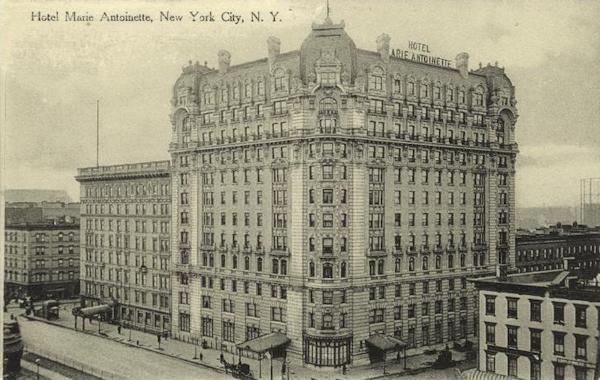Robert A.M. Stern’s 15 Central Park West, the Indiana limestone-clad landmark, clearly is today’s Upper West Side building with the greatest “OMG!” factor. Its understated name suggests that it’s classy to refer to showcase buildings by a number alone.

15 Central Park West
In contrast, the Upper West Side has traditionally gone in a big way for naming buildings after English estates and aristocrats. Some examples include Manchester House, The Chesterfield, The Chatsworth, Warwick Arms, The Endicott and The Alden.
Advertisement

Regarding French inspiration for naming, one example includes the 1910 Hotel Marie Antoinette, which was located between 66th and 67th Streets and Broadway. Later called the Dauphin Hotel, it was demolished as Lincoln Center was being developed.

Hotel Marie Antoinette, c/o NYPL Digital Collections
In the 1920s, building names also included other European references. Some, but fewer, like the Dakota, were named for locations in the US. A particularly eccentric 1916 twelve-story apartment building, The Cliff Dwelling at 243 Riverside Drive, reflects the Mayan and Aztec motifs and associations preferred by Herman Lee Meader, its architect.
Some Emery Roth buildings such as the Eldorado (mythical South American city of untold riches) and the 1930s San Remo (an Italian Village), carry the names of buildings that occupied their sites in years before the newer buildings were constructed.

The Eldorado
The Apthorp on 79th and Broadway was named for Charles Ward Apthorp, a property owner who owned a mansion further uptown on 91st Street called Elmwood.
Advertisement
New York Times author Daniel Schneider refers to an 1984 book, “Living it Up: A Guide to the Named Buildings of New York” by Jerry E. Patterson, suggesting that the Sylvia on West 76th Street was linked to the heroine of Shakespeare’s Two Gentleman of Verona. More generally, Schneider explains that at the end of the 19th Century and on into the early 20th Century, real estate developers gave New York City apartment houses names that suggested nobility, grand estates, historic importance and literary distinction. The goal was to position these new buildings above associations with earlier tenements
The understanding of the source of a building’s name is more clearly evident when it announces the status of the owner of the business that occupied it. For example, the J.M. Horton Ice Cream Company, whose sign crowns the top of the building that still stands at 302 Columbus Avenue. The business is reported to have occupied the site from 1892 to 1922.
Current day explorations into the history of building names turn up odd associations and mistakes that have been passed down and repeated often. The Evelyn, for example, is often thought to be a reference to Evelyn Nesbit, the chorus girl whose husband Harry Thaw famously murdered architect Stanford White, his wife’s former lover. But, as Christopher Gray of the NY Times points out, “She would have been a babe in arms” at the time the building was built in 1894.
Architect Emery Roth’s Oliver Cromwell on West 72nd Street was his favorite building, according to his great granddaughter, Robyn Roth-Moise, who told me during our recent interview. It was named for the English general Oliver Cromwell, known for making England a republic and also for anti-Irish policies.
Anyone who lives on the Upper West Side knows the half-timbered style of the Zabar’s complex on Broadway as a familiar landmark. The name of this building can only be thought of as Zabar’s. But, the structure owes its distinctive look to Aaron Chinitz, who opened the Tip Toe Inn on West 86th Street in 1915. Street level storefronts were part of the original design. The complex was completed in 1920 and became known as the Calvin Apartments. Zabar’s began its enterprise there in 1941.





The Master, 310 Riverside Drive, corner of 103 and Riverside Drive. • Patrons and ardent believers in arts education, Louis and Nettie Horch financed the construction of the Master Building in 1929. It was named for The Master Institute of United Arts, established in 1921 by Mr. and Mrs. Horch, in collaboration with Russian artists Nicholas and Helena Roerich. The Art Deco skyscraper housed an international arts center, as well as The Roerich Museum, classrooms, a restaurant, library, and theater. It was also home to many full-time residents in the residential portion known as the Master Apartment Hotel. Most tenants lived in the affordable studio apartments.
The Master Apartments is a very early example of an all electric building. Also, the original floors are made of cork and best of all the large black finial on top the building is a spiritual symbol, but forgetting it’s origin.
Just discovered your website and learned few things about the Upper West side. Thanks.